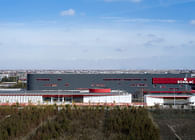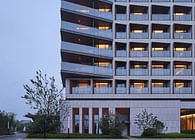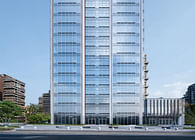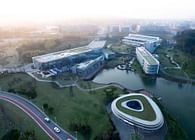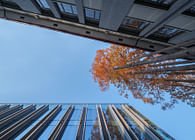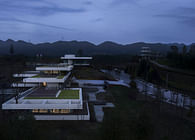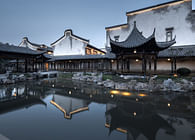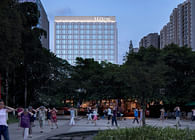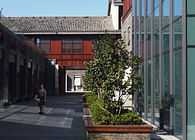
Shanghai, CN
1、 Thoughts on City Hotels
Urban hotels are often limited by high floor area ratio and efficient operation strategy. With intensive shape and efficient plane, it is difficult to create bright spots in space and create a sense of vacation in low-density and loose hotels. In addition, city hotels often emphasize functional rationality, supplemented by decorative elements that extract local characteristics or characteristics of the times. Aesthetics is more of an ornament or a simple form of reproduction. It's like a cold machine packed in a beautiful box. Although it's very good, it's not moving. In particular, the hotels in the suburbs, although they have certain environmental resources, cannot meet the needs of resort hotels, so their internal shaping becomes particularly important.
While satisfying the operation logic, function and economy, the case endows urban hotels with more sense of vacation and localization, and from the perspective of modern architecture, explores its coherent and reasonable underlying spirit expression, space shaping, plane and elevation logic, and construction logic.
2、 Overall design - high plot ratio vs holiday feeling
The hotel plot covers an area of 12050 square meters, with a floor area of 14070 square meters and a floor area ratio of 1.17. 150 guest rooms are required. This floor area ratio is very high for hotels that want to have a sense of vacation. It needs to be weighed between a multi-layer hotel and a high-rise hotel with courtyards.
Although the project plot is close to Lake Xiang, there is a Mayan Water Park between it and Lake Xiang. The low area is mainly green landscape, while the high area can see the lake landscape. The public area interacts with nature, and the guest room area overlooks Elephant Lake. Drawing lessons from the community relationship and the combination of virtual and real in Chinese gardens, the first floor is set with discrete multiple courtyard spaces to integrate the public area into the nature; the upper part is equipped with an intensive slab guest room tower to ensure that each guest room faces the lake view without being disturbed.
1. Multiple courtyards
The courtyard on the first floor is in a zigzag shape, which is centered on the core inner courtyard of 1000 m2 in the center. Two small-sized inner courtyards connected in series to the basement are set on the north side. Building space is based on the motif of discrete boxes, and the building is disassembled into multiple boxes according to different functions to maintain their independence. Small size box glass box space is nested in the box, increasing the interface between the building and the natural courtyard, so that more functions interact with the courtyard landscape.
The design explored the hotel function logic of "courtyard: L+L" layout, which not only ensures space experience, but also ensures efficient operation. The functions of the public area are divided into the following patterns: South drop off, East stay, North catering, and West banquet. The front desk is located in the southeast corner, which can support the south drop off and the east Maya Paradise walking direction; the kitchen support is located in the northwest corner, which can support catering in the north and banquet meeting in the west.
In combination with the landscape advantages of the Maya Paradise on the east side, the eastern courtyard is partially opened to create an open landscape where the inner courtyard and the eastern external site penetrate each other with transparent glass corridors.
2. All lake view guestroom building
The landscape demand of hotel rooms is different from the multi-directional landscape of open and interactive public areas. The guest room area needs a one-way landscape. We should not only have a good view of the landscape, but also pay attention to privacy. In order to meet the requirement that all guest rooms have a view towards the lake, the guest rooms are lined up along the side of the lake, and the traffic is located on the side away from the lake. Consider weakening the pressure of large buildings on the city, bending the body, and easily intervene in the site in the form of broken lines.
3、 Space experience - efficient operation vs natural and humanistic
1. Garden tour
The scattered public area courtyards not only bring people rich garden experience, but also provide effective space for hotel operation. The key shaping of a single core courtyard is conducive to saving landscape costs, making full use of the vacant land around the site, and creating more operational value.
Preamble Hall - First View of the Courtyard
The main entrance of the hotel is different from the front desk setting of conventional hotels. Instead, it is equipped with an "empty" experience hall, which provides a view of the inner courtyard, and separates the western banquet meeting line and the eastern guest check-in line, which do not disturb each other.
Lobby Bar - Island Space
The lobby bar is set as an independent glass box, separated from the main building, surrounded by green trees and water systems, blurring the indoor and outdoor boundaries. The lobby bar is also the largest glass box in the inner courtyard, becoming the visual focus of the inner courtyard.
Catering Area - Courtyard
The hotel has a multi-functional restaurant, which can be flexibly switched in different periods of use to improve the efficiency of use. The interior is placed into a small-scale inner courtyard to limit the boundary between the private room and the temporary site, forming a panoramic dining environment. The outside of the private room of the Chinese restaurant is close to the road, and a small inner courtyard is used to isolate road interference. The inner courtyard was dug to the first floor underground, and a side courtyard leading to the underground was set on the west side, providing sunshine for the functional rooms and staff dining room on the first floor.
Ballroom - extension
The lobby of the banquet hall faces the outside and has an exclusive open landscape; Use the boundary with the surrounding buildings to build the wedding lawn.
2. Overlook
The viewing experience of the guest room building is integrated with the architectural modeling, and the space and elevation are designed in an integrated way. Due to the multiple functions of standard guest rooms, corner suites and roof viewing gardens, the facades reflect different functional requirements with "three-dimensional grids" of different scales, such as the open large-span grid of the roof viewing platform, and the cantilevered grid of the suites facing the water show. Through ingenious design, a sense of rhythm is formed. Compared with the conventional decorative facade, the form of "dragon scale" has a clear sense of composition, which adds to the real identity of the building.
4、 Modeling construction - low cost vs high completion
As a hotel, the facade cost requirement of about 1000 RMB at the beginning of the design was a huge problem for the design, and de decoration was necessary. Therefore, the uniqueness of the balcony was designed with "small actions" and "rhythmic sense" was used to "design" in combination with the repeatability of the hotel rooms.
1. Guest room balcony
As the core element of the facade, the balcony adopts the wood grain aluminum plate flying out of the broken line, and the wall top is integrated to create a warm holiday feeling for the guests with the wrapped wood color. The integration of architecture, interior and lighting, the integration of multi professional design and multi material handover, and the final clear and stylized balcony shape. The balcony lamp is more outside than the general hotel, which emphasizes the oblique lattice top with the light, shaping the sparkling effect, and reflects the unique temperament of the hotel with the intention of "dragon scale". Through the research on the size and direction of plate slits, it is avoided to reduce the cost of super large plate size and improve the flatness; Control the texture and division position, and weaken the splicing to achieve the overall effect.
The glass balustrade of the end balcony extends downward to block the balcony structural plate, and is fixed in the form of a slot. Only an 80x80mm stainless steel pressing plate is reserved on the upper part, which is combined with the sunlight reflection film glass and aluminum backing plate to create a light and clean visual image.
2. Corridor facade
The window wall system and natural smoke exhaust are adopted for the side glass of the corridor to save the cost; the facade louver is suspended outside the wall to ensure the privacy of the sunshade and guest room walkway. The facade louvers are arranged and combined by two unit modulus components of different sizes. The odd and even layers are staggered to form a sense of flow similar to water waves. The overall module is combined with the column grid to block the visibility of structural columns on the facade. The lamp is hidden in the horizontal profile, and the light cannot be seen.
3. Entrance canopy
The entrance canopy is 25 meters long, and the structure is in the form of inclined columns to create a more relaxed and transparent drop off space. Wood grain aluminum plate is used to wrap the side of the steel column in the open air to avoid the aging and peeling of the fluorocarbon paint on the steel column, which will not only save materials but also form the effect of steel wood structure. The bottom of the canopy combines with the light to create a suspended visual effect, eliminating the sense of thickness of the roof. In order to create a simple and powerful entrance space with oriental meaning.
Epilogue
Although Four Points by Sheraton Nanchang is positioned as a city hotel, we believe that adding natural vitality to it and creating a sense of vacation and humanity will sublimate the value of the hotel, which is also the real value of design. The total cost of the hotel investment per party does not exceed 10000, which is very efficient in hotels with an area of more than 10000 square meters. As a four-star hotel, after opening, the room price is not less than that of five-star hotels in urban areas, and the occupancy rate is far ahead. The construction and design of hotels should not blindly pursue high investment. In the current economic environment, "characteristics" may be the first element of hotel development and construction.
Status: Built
Location: Nanchang, CN
Firm Role: Head Designer
Additional Credits: Design Team: Huang Ouhai, Yong Youlong, Liu Jie, Li Ying, Zhang Chendong, Liu Xiaoqing, Wang Xiaoxiao, etc.
Clients: OCT Nanchang Industrial Development Co., Ltd.
Architectural design: DuShe Architectural Design Co.Ltd., Shanghai
Cooperative design: JZFZ Architectural Design Co., Ltd
Curtain wall consultant: Shanghai Ruibai Building Exterior Wall Design Consulting Co., Ltd
Lighting design: Confucian visual lighting design
Construction party: Taixing First Construction Group Co., Ltd
Photo credits: Zhang Yong, Interior photos provided by the Owner
Completion Year: 2022
Gross Built Area: 21107㎡
Project location: Yanwu Road, Xihu District, Nanchang, Jiangxi Province, China




